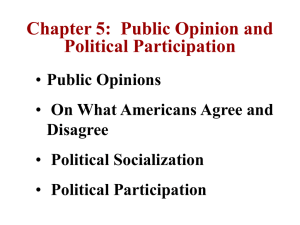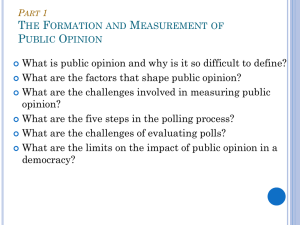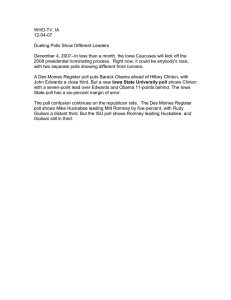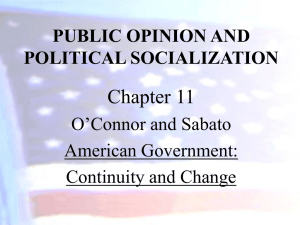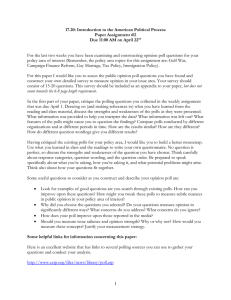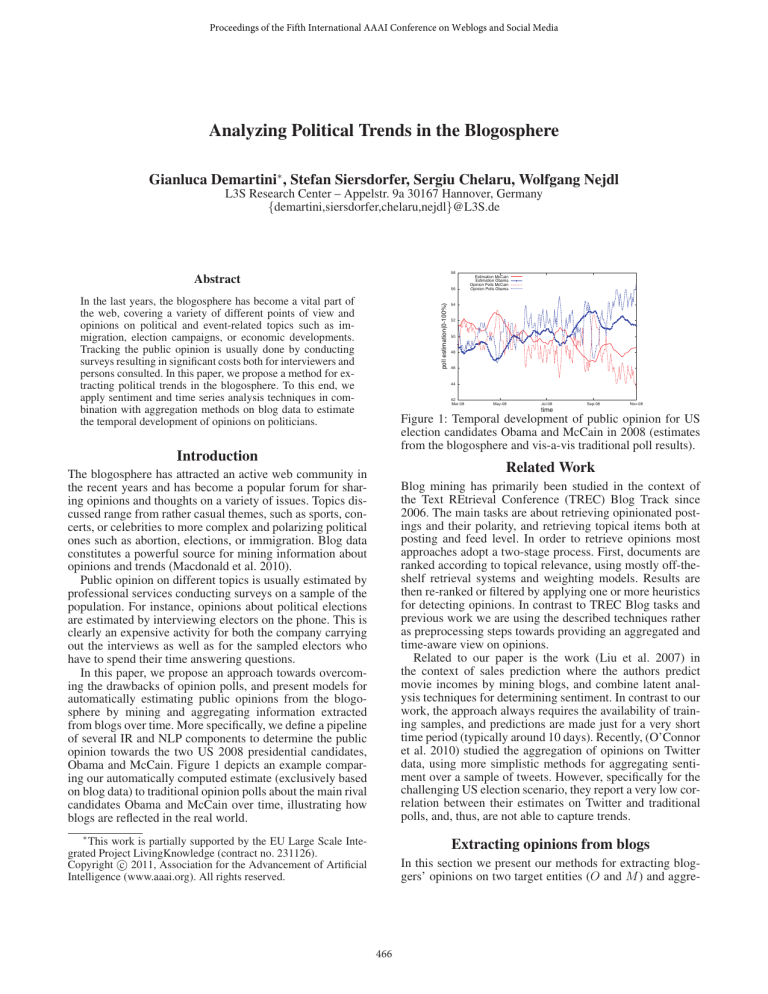
Proceedings of the Fifth International AAAI Conference on Weblogs and Social Media
Analyzing Political Trends in the Blogosphere
Gianluca Demartini∗ , Stefan Siersdorfer, Sergiu Chelaru, Wolfgang Nejdl
L3S Research Center – Appelstr. 9a 30167 Hannover, Germany
{demartini,siersdorfer,chelaru,nejdl}@L3S.de
58
Abstract
56
poll estimation(0-100%)
In the last years, the blogosphere has become a vital part of
the web, covering a variety of different points of view and
opinions on political and event-related topics such as immigration, election campaigns, or economic developments.
Tracking the public opinion is usually done by conducting
surveys resulting in significant costs both for interviewers and
persons consulted. In this paper, we propose a method for extracting political trends in the blogosphere. To this end, we
apply sentiment and time series analysis techniques in combination with aggregation methods on blog data to estimate
the temporal development of opinions on politicians.
Estimation McCain
Estimation Obama
Opinion Polls McCain
Opinion Polls Obama
54
52
50
48
46
44
42
Mar-08
May-08
Jul-08
Sep-08
Nov-08
time
Figure 1: Temporal development of public opinion for US
election candidates Obama and McCain in 2008 (estimates
from the blogosphere and vis-a-vis traditional poll results).
Introduction
Related Work
The blogosphere has attracted an active web community in
the recent years and has become a popular forum for sharing opinions and thoughts on a variety of issues. Topics discussed range from rather casual themes, such as sports, concerts, or celebrities to more complex and polarizing political
ones such as abortion, elections, or immigration. Blog data
constitutes a powerful source for mining information about
opinions and trends (Macdonald et al. 2010).
Public opinion on different topics is usually estimated by
professional services conducting surveys on a sample of the
population. For instance, opinions about political elections
are estimated by interviewing electors on the phone. This is
clearly an expensive activity for both the company carrying
out the interviews as well as for the sampled electors who
have to spend their time answering questions.
In this paper, we propose an approach towards overcoming the drawbacks of opinion polls, and present models for
automatically estimating public opinions from the blogosphere by mining and aggregating information extracted
from blogs over time. More specifically, we define a pipeline
of several IR and NLP components to determine the public
opinion towards the two US 2008 presidential candidates,
Obama and McCain. Figure 1 depicts an example comparing our automatically computed estimate (exclusively based
on blog data) to traditional opinion polls about the main rival
candidates Obama and McCain over time, illustrating how
blogs are reflected in the real world.
Blog mining has primarily been studied in the context of
the Text REtrieval Conference (TREC) Blog Track since
2006. The main tasks are about retrieving opinionated postings and their polarity, and retrieving topical items both at
posting and feed level. In order to retrieve opinions most
approaches adopt a two-stage process. First, documents are
ranked according to topical relevance, using mostly off-theshelf retrieval systems and weighting models. Results are
then re-ranked or filtered by applying one or more heuristics
for detecting opinions. In contrast to TREC Blog tasks and
previous work we are using the described techniques rather
as preprocessing steps towards providing an aggregated and
time-aware view on opinions.
Related to our paper is the work (Liu et al. 2007) in
the context of sales prediction where the authors predict
movie incomes by mining blogs, and combine latent analysis techniques for determining sentiment. In contrast to our
work, the approach always requires the availability of training samples, and predictions are made just for a very short
time period (typically around 10 days). Recently, (O’Connor
et al. 2010) studied the aggregation of opinions on Twitter
data, using more simplistic methods for aggregating sentiment over a sample of tweets. However, specifically for the
challenging US election scenario, they report a very low correlation between their estimates on Twitter and traditional
polls, and, thus, are not able to capture trends.
∗
This work is partially supported by the EU Large Scale Integrated Project LivingKnowledge (contract no. 231126).
c 2011, Association for the Advancement of Artificial
Copyright Intelligence (www.aaai.org). All rights reserved.
In this section we present our methods for extracting bloggers’ opinions on two target entities (O and M ) and aggre-
Extracting opinions from blogs
466
For SVMs a natural confidence measure is the distance of
a test sentence vector from the separating hyperplane. After
linearly normalizing classification scores for a sentence st
to be in the range [−1, 1], we compute the sentiment values
for posting p with respect to entities O and M . These values
are then combined to the preference estimate s(p).
gating them over time. The approach we propose for estimating the public opinion about politicians consists of three
main steps: 1) retrieval, 2) sentiment classification, and 3)
aggregation.
Estimating Opinion Polls
Sentiment Aggregation. For a time interval t = [t1 , t2 ]
we consider all postings Pt = {p ∈ P : t1 ≤ T S(p) ≤ t2 }
relevant to entities O and M published in that interval,
where T S(p) is the timestamp of posting p. We then use
data extracted from this set to estimate an opinion value
poll(t) ∈ [−1, +1] for time interval t. Given the preference estimates s(p) for postings we want to estimate poll(t)
through aggregation. Let Sel be a function for selecting the
subset Sel(Pt ) = Pt ⊆ Pt we want to consider for aggregation, and f : [−1, +1] → [−1, +1] be a monotonically
increasing function with f (−1) = −1 and f (1) = 1. Then,
we can compute
an aggregated value as follows: poll(t) =
1
p∈Sel(Pt ) f (s(p)) describing, in general form, an
|Sel(Pt )|
increase of the estimate poll(t) with an increasing number
of high preference values s(p). The simplest instantiation
of such an aggregation is an Averaging model with all postings selected and no transformation ofscores (i.e., f being
the identical function): poll(t) = |P1t | p∈Pt s(p). Alternatively, we can apply a Counting model using thresholds on
the sentiment scores: Sel(Pt ) = {p ∈ Pt |s(p) < thres1 ∨
s(p) > thres2 } where thres1 and thres2 are thresholds
used for discarding objective postings for which there is no
clear sentiment assigned. Scores exceeding the thresholds
can then be transformed into explicit binary “votes” to be
counted. These votes are then averaged over as described
above.
Retrieving Relevant Postings. From the blogosphere we
first retrieve a set P = {p1 , . . . , pn } of blog postings relevant to entities O and M . In the Obama vs. McCain example
we were conducting this based on simple keyword search,
assuming that all postings containing at least one of the candidates names were potentially useful for further analysis.
Assigning Sentiment Scores. We aim to assign sentiment
values s(p) to blog postings p. For our scenario with two
concurrent entities O and M , we assume that s(p) lies in
the interval [−1, +1] with s(p) = 1 referring to a maximum positive opinion expressed about O, and, conversely
s(p) = −1 corresponding to a totally positive opinion on
the competing entity M .
The first option to obtain these sentiment values is to exploit a lexical resource for opinion mining such as SentiWordNet (Esuli and Sebastiani 2006) built on top of WordNet (Fellbaum 1998). In SentiWordNet a triple of three senti
values (pos, neg, obj) (corresponding to positive, negative,
or rather neutral sentiment flavor of a word respectively) are
assigned to each set of synonymous words w in WordNet.
We define SentO (p) as the set of sentences in a posting
p which contains entity O but not M and we analogously
define SentM (p). Let Lex(st) be the set of words w from
sentence st that can be assigned a sentiment value based on
the available lexicon. For a sentence st we aggregate positive and negative sentivalues
for opinionated words as fol
pos(w)−neg(w)
, e ∈ {O, M }
lows: sentie (st) = w∈Lex(st)
|Lex(st)|
where, pos(w) and neg(w) are the positive / negative values
for the word w in the lexical resource, and st ∈ Sente (p).
We can now compute the sentiment of the posting p about
each of the two considered
entities independently. Thus,
Adjusting Aggregated Opinion Estimates
The assumption that blog articles fully reflect the opinion
of the overall population is rather unrealistic. We want to
address this issue and introduce model parameters to adjust the poll estimation function poll(t). The first issue to
account for are publishing delays: people can express their
opinions in blogs at any point in time while phone interviews are carried out periodically. In order to address this
issue, we introduce a lag factor that shifts poll(t) earlier
or later in the timeline. Although blog writing technology
has become more and more accessible to a broad range of
people, users writing blogs are not necessarily representative for the whole population. To account for this difference
we introduce an additive bias constant to our model. Finally,
sentiment values computed as described in the previous subsection might require some re-scaling in order to reflect the
actual “strength” of the opinions. We therefore introduce a
constant multiplicative factor (scale) for the produced estimate. Considering all these factors we transform poll estimation for a time interval t in the following way:
AdjustedP oll(t, lag, bias, scale) = (poll(t+lag)+bias)·scale
To account for general noise in the data we introduce a
smoothing function over the estimates. We apply a simple
moving
average over past estimates: AdjustedP oll(t, k) =
sentie (st)
st∈Sente (p)
, e ∈ {O, M }.
we define: se (p) =
|Sente (p)|
The values of these estimators lie in the interval [−1, +1]
where −1 indicates a strong negative opinion and +1 a
strong positive opinion about the candidate e. Then, we
compute the overall preference estimate for posting p as
M (p)
. The estimator s(p) assumes values in
s(p) = sO (p)−s
2
[−1, +1] where −1 indicates a preference towards M and
+1 a preference for O.
A second option for computing the sentiment of bloggers
with respect to given entities is the application of text classification on a sentence level. We use a standard Bag-ofWords representation of sentences with stemming, stopword
removal, and TF weighting. An SVM classifier is trained
on opinionated data from different sources to ensure a diverse coverage: manual judgments from the TREC 2008
Blog Track (Ounis, Macdonald, and Soboroff 2008) consisting of 18,142 opinionated blog postings, 100,000 reviews
crawled from the website epinions.com assigned to a positive or negative class considering the 1 or 5 stars judgement
associated with the textual review, and a sentence polarity
dataset (Pang and Lee 2005).
k−1
j=0
poll(t−j)
k
where k is the number of past time intervals
considered for smoothing.
467
Estimation vs. Ground Truth
Supervised Techniques to Improve Poll Estimations
Estimation vs. Ground Truth
0.14
0.12
Estimation
Ground Truth
Ground Truth
Estimation
0.12
0.1
In addition to the blog information a history of traditional
opinion poll values might be available, resulting in a
supervised scenario in which model parameters can be
learned. We optimize parameter values introduced in the
previous section by minimizing the average root mean
squared error of poll(t, lag, bias, scale) compared to the
values obtained from poll results of the given “training”
history. In detail, we learn the best parameter values using
the Nelder and Mead simplex approach (Nelder and Mead
1965). Specifically,
the objective function is the following:
n
1
2
argmin
t=1 (p(t, lag, bias, scale, k) − gt(t))
n
Figure 2: (a) Estimation of opinion polls as performed by
a linear forecaster (LinFor) and (b) by the combination of
a linear TSA model with our supervised Counting Model
(LexCountLinFor).
where gt(t) is the traditional poll value for the t-th time
interval. Furthermore, we apply TSA techniques in order
to predict the continuation of a data series of opinion
polls. In this paper, we use linear forecasting (Wei 2006)
and polynomial regression (Cowpertwait and Metcalfe
2009) for predicting values pT SA(t) of the poll at time
t which can, for instance, be linearly combined with
the blog data-driven prediction poll(t): pollT SA+blog (t) =
λ · AdjustedP oll(t, lag, bias, scale, k) + (1 − λ) · pT SA(t)
where λ is a tuning parameter for controlling the influence
of one or the other type of prediction.
n
RM SE(p, gt) = n1 i=1 (pi − gti )2 where pi is the estimate and gti is the poll value for the i-th time interval.
In the unsupervised setting, the task is to estimate the
temporal development of opinions given only the blog data
while for the supervised setting we assume that a history of
past polls is given. Our experiments use the first 50% of the
ground truth for learning model parameters and the remaining 50% for evaluating the models. We evaluate also the unsupervised models on the last 50% of the data in order to get
comparable results.
0.06
0.04
0.02
0
140
165
time interval
(a)
Experimental Evaluation
0.04
0.02
0
-0.04
-0.04
-0.06
115
0.06
-0.02
-0.02
lag,bias,scale,k
190
215
230
-0.06
115
140
165
190
215
230
time interval
(b)
Evaluation Results. We want to examine whether our
sentiment aggregation methods are useful for predicting
public opinion trends and whether supervised techniques
as well as TSA methods can help at this task. We first
measured the quality of the purely data-driven unsupervised models and aggregation techniques: the lexicon-based
model using SentiWordNet to compute sentiment of postings and the Averaging aggregation model (LexAvg), the
classification-based model using an SVM classifier trained
on three opinionated datasets together with the Averaging
aggregation model (ClassifyAvg), the lexicon-based model
with the Counting aggregation model (LexCount), and the
classification-based model together with the Counting aggregation model (ClassifyCount). For these techniques, we
also test the performance of their supervised counterparts
where parameters are learned on the initial 50% of the data.
Moreover, we compare against TSA methods that only
exploit past available ground-truth to estimate future trend
of opinions: a linear model based on forecasting techniques
(i.e., Hunter’s simple exponential smoothing forecast model
(Wei 2006)) (LinFor), a linear regression model to fit a deterministic trend to training data (Cowpertwait and Metcalfe
2009) (LinReg), and a polynomial regression model of degree 2 (Cowpertwait and Metcalfe 2009) (QuadReg). Finally, we compute the linear combination of our best supervised approach in terms of RMSE, LexCount, with the best
TSA model, LinFor, and denote it LexCountLinFor.
In addition, we compare the proposed techniques with a
very simple baseline just taking into account the plain number of retrieved postings for each candidate in a time intero+om
val. More specifically, we compute poll(t) = o+m+om
−
m+om
o+m+om where o indicates the number of postings in t about
Obama, m about McCain, and om about both (Count1) and
another variant where the postings containing both entities
are not taken into account (Count2).
Scenario and Data. For computing opinion estimates
about the two main rival candidates Obama and McCain we
applied our methods to the Blogs08 dataset (Macdonald, Ounis, and Soboroff 2010) which is composed of 28,488,766
blog postings from the 14th January 2008 to the 10th February 2009. Using a language classifier (Cavnar and Trenkle
1994) we estimated that about 65% of the postings are in
English. Building an inverted index after stemming and removing stopwords from the English postings, we retrieved
670,855 matching the disjunctive query “obama OR mccain” which formed our working set.
As ground truth for opinion polls we used the data provided by Gallup, a professional service, tracking public
opinion by means of telephone polls. This dataset provides
results of interviews with approximately 1500 US national
adults conducted over the time period from March until
November 2008 for a total of 230 polls.
Preprocessing and Setup. We processed the set of relevant postings using state-of-the-art techniques for web
page template removal (Kohlschütter, Fankhauser, and Nejdl
2010) in order to restrict our analysis to the actual content
of the postings. We then used NLP tools1 to split postings
into a set of sentences and to POS-tag them. On the resulting output we did lookups in SentiWordnet to obtain positivity and negativity scores for each adjective in a sentence.
For the ML-based sentiment score assignment, preprocessed
sentences were classified using SVMlight (Joachims 1999)
to obtain positive/negative scores.
In order to evaluate the effectiveness of the proposed
models, we computed the Root Mean Squared Error
(RMSE) between the estimation and the true poll value:
1
0.08
poll estimation [-1 1]
poll estimation [-1 1]
0.1
0.08
http://gate.ac.uk/
468
in contrast to our data-driven models. On the other hand,
the combination of TSA with our models results in a low
RMSE and better captures changes of the public opinion
(Figure 2b).
Table 1: RMSE values for the estimation models on the last
50% of the timeline. The initial 50% are used for training
the model parameters of the supervised models.
Method
Count1
Count2
LexAvg
ClassifyAvg
LexCount
ClassifyCount
LinFor
LinReg
QuadReg
LexCountLinFor
RMSE
unsupervised supervised
0.1272
0.0653
0.3422
0.0632
0.0642
0.0556
0.0619
0.0608
0.0572
0.0483
0.1980
0.0482
0.0397
0.0405
0.0999
0.0394 (λ = 0.2)
Conclusion and Future Work
In this paper we presented an approach for estimating the development of public opinions over time by extracting and aggregating sentiments about politicians from the blogosphere.
Our experimental study in the context of the US 2008 election campaign showed that purely data-driven, unsupervised
approaches can already capture trends, peaks, and switches
for public opinions in the political domain. We achieved further improvements by utilizing, in addition to blog data, a
history of past opinion poll results for learning parameters
that capture intrinsic differences between blogosphere and
the “real world”. In our future work, we aim to enhance
our approach taking into account various user characteristics such as gender, age, or location.
Table 1 shows the RMSE values for all of the compared approaches2 . Figures 1, 2a, and 2b show the detailed temporal developments for the best unsupervised, time
series-based, and best overall approach (supervised datadriven learning linearly combined with TSA) respectively;
the ground truth using traditional polls from Gallup is shown
as dotted line.
All methods using sentiment-based blog analysis approximately capture trends, peaks, and switches in public opinions. Even purely data-driven unsupervised methods using
aggregated sentiments extracted from the blogosphere can
already estimate public opinion about electoral candidates
quite well (RMSE = 0.0572 for LexCount). Figure 1 further
illustrates the ability of unsupervised LexCount to match
opinion changes. The supervised counterparts of sentimentbased methods that exploit the history of past opinion polls
improve the quality of the up to 76% (RMSE = 0.0482 for
ClassifyCount) compared to the unsupervised approach by
tuning model parameters that take into account the intrinsic sample bias. The improvements over the unsupervised
approaches are statistically significant (t-test p < 0.05)
in all the cases. Learned parameters are lag, taking into
account time delays in estimations, smoothing to reduce
noise into the underlying data, bias to tackle the problem
of a non-representative sample, and scale to either amplify
or reduce the estimation. The combination of TSA techniques with supervised models learned on the available data
(LexCountLinFor) shows the best performance of all approaches resulting in overall statistical significant improvement of 39% compared to the best unsupervised approach
(LexCount) and of 69% compared to the best approach
based on posting volume (Count1) (see also Figure 2b for
the temporal development). Simply counting postings published about a candidate over time results in a comparatively
large estimation error (with RMSE = 0.1272 and 0.3422 for
Count1 and Count2 respectively), and, thus, is not suited
for the opinion estimation problem (see Table 1). The approaches based on sentiment classification and based on
lexica show comparable performance. Forecasting methods,
while respecting the general trend of the public opinion, do
not provide an indication of peaks and switches (Figure 2a),
References
Cavnar, W. B., and Trenkle, J. M. 1994. N-gram-based text
categorization. In Proceedings of SDAIR-94, 161–175.
Cowpertwait, P., and Metcalfe, A. 2009. Introductory Time
Series with R. Springer.
Esuli, A., and Sebastiani, F. 2006. SentiWordNet: A publicly available lexical resource for opinion mining. In Proceedings of LREC, volume 6. Citeseer.
Fellbaum, C., ed. 1998. WordNet: An Electronic Lexical
Database. MIT Press.
Joachims, T. 1999. Making large-scale support vector machine learning practical. Advances in kernel methods: support vector learning 169–184.
Kohlschütter, C.; Fankhauser, P.; and Nejdl, W. 2010. Boilerplate detection using shallow text features. In WSDM ’10,
441–450.
Liu, Y.; Huang, X.; An, A.; and Yu, X. 2007. ARSA: a
sentiment-aware model for predicting sales performance using blogs. In SIGIR ’07, 607–614. ACM.
Macdonald, C.; Santos, R. L.; Ounis, I.; and Soboroff, I.
2010. Blog track research at TREC. SIGIR Forum 44:58–75.
Macdonald, C.; Ounis, I.; and Soboroff, I. 2010. Overview
of the TREC 2009 Blog track. TREC 2009.
Nelder, J., and Mead, R. 1965. A simplex method for function minimization. The computer journal 7(4):308.
O’Connor, B.; Balasubramanyan, R.; Routledge, B. R.; and
Smith, N. A. 2010. From tweets to polls: Linking text sentiment to public opinion time series. In ICWSM.
Ounis, I.; Macdonald, C.; and Soboroff, I. 2008. Overview
of the TREC 2008 Blog Track. In TREC 2008.
Pang, B., and Lee, L. 2005. Seeing stars: Exploiting class
relationships for sentiment categorization with respect to rating scales. In Proceedings of the ACL.
Wei, W. 2006. Time series analysis: univariate and multivariate methods. Addison-Wesley.
2
Experiments show that the best thresholds for the Counting
model are (0,0), that is, taking all postings into consideration.
469


